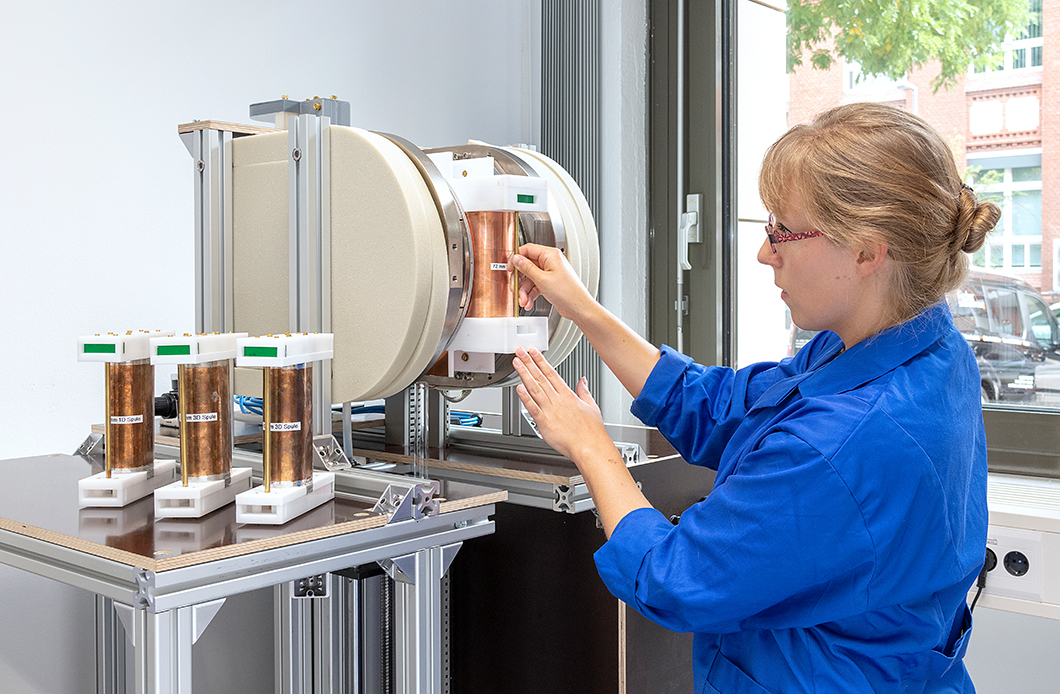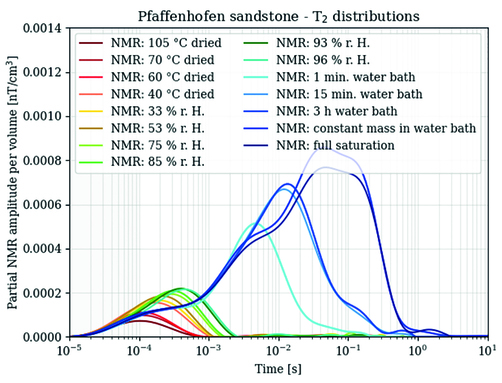
Sarah Munsch working at the NMR tomograph
Source: BAM
Project period
17/07/2017 - 31/12/2023
Project type
BAM project
Project status
Ongoing
Description
With this research, a new approach based on adsorption theory shall be developed, that enables the assignment of NMR signals to pore sizes in the case of partial saturation.
Location
Bundesanstalt für Materialforschung und -prüfung
Unter den Eichen 87
12205 Berlin
Sandstone drill core Source: BAM
The development of environment-friendly and CO2-reduced building materials is nowadays of high interest. However, the early hydration mechanisms and durability properties of newly developed cementitious materials are not fully understood. The use of the 1H NMR method which is sensitive to the hydrogen mobility, the pore space geometry and transport properties could be of great benefit, but the signal interpretation is mostly based on the assumption of full saturation. This still represents a limitation of the method that needs to be overcome.
Source: BAM
The pore space of cementitious building materials is typically only partially saturated during hydration and transport mechanism. Consequently, the interpretation of NMR and the assignment of the signal to pore sizes becomes much more complex as standard approaches are based on the assumption of full saturation. This project aims at the development of a new approach that enables the assignment of NMR signals to pore sizes measured in partially saturated porous media.
Source: BAM
In this project, 19 sandstone types are measured with NMR at full and several degrees of partial saturation, which are achieved by moisture adsorption. The adsorbed water amount is then calculated based on the adsorption theory and the material specific pore-size distribution. Using this approach, the amount of partially and fully saturated pores can be precisely calculated for each saturation step. This knowledge is used then for the interpretation of the measured NMR signals.
Source: BAM
Bundesanstalt für Materialforschung und -prüfung (BAM)
Department Non-Destructive Testing
Interpretation of NMR signals in partially saturated sandstones based on adsorption theory
The development of environment-friendly and CO2-reduced building materials is nowadays of high interest. However, the hydration mechanisms and durability properties of such new materials require a detailed investigation. 1H NMR seems to be a valuable tool as it enables the non-destructive and in-situ determination of pore space and durability properties such as the mobility of hydrogen protons, porosity and moisture content of the samples. Moreover, at full saturation, NMR signals can be even assigned to pore sizes.
However, when investigating materials during hydration and studying moisture transport processes, the pore systems are usually partially saturated, which makes the interpretation and assignment of NMR signals to pore sizes much more complex. This is due to the fact, that the NMR relaxation time of hydrogen protons in porous materials depends on numerous factors. Besides the molecular bonding, the relaxation behaviour is also influenced by the environment, which means e. g. the pore geometry and the surrounding mineral composition. At partial saturation, the NMR relaxation times are shortened due to two main causes: 1. the moisture is mainly placed in smaller pores (spatial confinement); 2. water films within already partially saturated pores result in short relaxation times due to a stronger bonding to the pore wall. Consequently, short relaxation times may result from two different regimes within one sample and cannot directly be assigned to pore sizes. The difference between full and partial saturation may be seen in the figure below, where the NMR relaxation time distributions at various saturation states are shown.
In order to assign NMR signals of partly saturated systems to pore sizes as well, we currently develop an approach at BAM that is based on adsorption and takes the calculation of the adsorbed water layer thickness into account. For this, samples of 19 different sandstone types were partially saturated by moisture adsorption within desiccators with salt solutions that regulate specific relative humidities. Based on adsorption theory, the adsorbed water amount may be calculated depending on the specific pore-size distribution of a material. This means that for each saturation degree the amount of partially and fully saturated pores can be mathematically calculated. This knowledge then facilitates the interpretation of the according NMR signals measured on partially saturated samples in the lab. The used NMR tomograph at BAM has a high signal-to-noise ratio and allows very short echo times of around 50 µs.

NMR T2 relaxation-time distributions of the Pfaffenhofen sandstone at various saturation states
Source: BAM, Department Non-destructive Testing
Funding
The HyBeMa project is funded through internal BAM funds.


